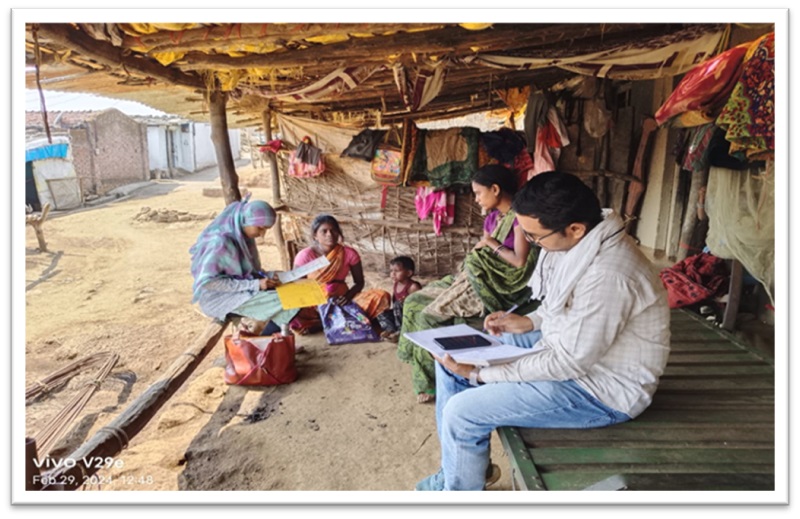Introduction
The Melghat region, situated in the Amravati district, comprises two main talukas: Dharani and Chikhaldara. These areas, characterized by a significant tribal population, are part of the NITI Aayog's Aspirational Block Programme. Melghat is famous for its Tiger Reserve, while Chikhaldara is a renowned hill station and the only coffee-growing region in the state. The area's predominantly hilly terrain offers scenic views but also presents a challenging landscape. This geographical setting greatly impacts the lifestyle and health conditions of the local population.
Problem Statement
Melghat faces
significant health challenges, including high infant mortality rate (IMR) and
maternal mortality rate (MMR). In 2018-19, the IMR was 36, and the MMR was 87.
The region also struggles with severe acute malnutrition (SAM) and moderate
acute malnutrition (MAM). During the pre-project analysis, a significant
concern was identified: nearly 70% of infant mortality in Melghat occurred
within the first month of birth, with 60% of these deaths taking place at home.
It became evident that institutional delivery, a fundamental aspect of
reproductive and child health, was lacking. Annually, approximately 7,000
deliveries occur in Melghat, with 30% of these being premature. This results in
a substantial percentage of low
birth weight babies and neonatal deaths,
primarily due to septicemia, pneumonia, and other diseases. In 2022, of the
7288 total deliveries, 1135 were home-based, contributing to the Higher IMR and
MMR in the Melghat region.
Root Cause Analysis
§Most of
the Villagers preferred Home deliveries instead of institutional delivery due
to their superstations & beliefs.
§Initially,
communication was a challenge due to the local tribe's Korku language. To
address this, two counselors were stationed at each Primary Health Center to
provide counseling in Korku.
§The
administration conducted the analysis of last five years of data related to
IMR, MMR, Institutional Delivery & Child Deaths.
§From the
Analysis we found that the IMR was 31, and the MMR was 114. The region also
struggles with severe acute malnutrition (SAM) and moderate acute malnutrition
(MAM). all these indicators were on the rising side throughout this 5 years.
|
Indicators
|
2017-18
|
2018-19
|
2019-20
|
2020-21
|
2021-22
|
|
IMR
|
31
|
36
|
30.49
|
27.36
|
20.88
|
|
MMR
|
114
|
93
|
124.50
|
156.79
|
65.17
|
|
Institutional
Delivery
|
74%
|
77
%
|
78%
|
80%
|
80%
|
|
Child
death
(0-1
years )
|
217
|
245
|
196
|
171
|
149
|
§During
the pre-project analysis, a significant concern was identified nearly 70% of infant mortality in Melghat
occurred within the first month of birth, with 60% of these deaths taking place
at home. It became evident that institutional delivery, a fundamental aspect of
reproductive and child health, was lacking. Annually, approximately 7,000
deliveries occur in Melghat, with 30% of these being premature. This
rlow-birth-weightts
in a substantial percentage of low birth weight babies and neonatal deaths, primarily
due to septicemia, pneumonia, and other diseases.
Introduction of "Mission 28 "
§The
administration organized a comprehensive
workshop & demonstrated the Root cause Analysis of the health indicators to
all the relevant staffs.
§To effectively address the health
challenges an innovative campaign named "Mission
28" for Melghat was launched in 2022. Under Mission 28, a proactive approach
was adopted to monitor and support pregnant women and lactating mothers 28 days
before delivery and 28 days after delivery. The objectives of Mission 28
include increasing institutional deliveries, reducing infant mortality rates
(IMR), maternal mortality rates (MMR), and child deaths
§The
campaign takes a proactive approach, closely monitoring pregnant and lactating
mothers 28 days before and after delivery. ASHA workers from the Health
Department and Anganwadi workers from the ICDS Department were mobilized for
this 56-day period.
§Conducted comprehensive training for all
employees from the Women and Child Development Department and Health
Department. The training was strategically organized, with ASHA workers leading
on the first day, Anganwadi workers on the second day, and ASHA workers again
on the third day to prevent fatigue.
§Nearly 1,000 high-risk pregnant
women are identified and monitored annually by specialized doctors
§Counseled pregnant women to encourage
hospital births, provided guidance on breastfeeding techniques to lactating
mothers, and ensured prompt medical attention for infants when needed
§Medical infrastructure, including 3
Nutritional Rehabilitation Centers (NRC), Blood Banks, and 62 Child Treatment
Centers (CTC) in Primary Health Centers (PHC) were established in Villages.
§Specialized
doctors were deputed in critical villages for 15 days each month to support the
initiative. also vehicles for Pregnant Women and 2 Ambulance for
neonatal were arranged by the Administration.
•Wage
loss compensation was provided under the Manav Vikas scheme.
•Dedicated
Helpline was set up for Pregnant women to seek help from Doctors.
IMPACT OF “MISSION 28”

The above Charts shows the significant improvement in the
indicators like IMR, MMR, institutional delivery,
ØThere
has been a notable reduction in IMR from 36
in 2018-19 to 19.98 in 2023-24,
which is closest to state average.
ØMMR
decreased from 93 in 2018-19 to 28.92 in
2024-25.
ØInstitutional
delivery rates increased from 77% in 2018-19
to 94% in 2023-24,
ØChild
Deaths decreased from 245 in
2018-19 to 128 in 2023-24.
Monitoring & Evaluation
§For
effective monitoring, the administration introduced three cards: Yellow (before
delivery), Saffron (for postnatal care up to 28 days), and Green (for neonatal
care up to 28 days)
§Flying
Squad was established for effective Monitoring of the Initiative & Helpline
numbers were established to facilitate convenient communication.
§Monthly reviews were conducted to assess the progress of
awareness programs led by Sevikas and ASHA Workers. This ongoing monitoring ensured that the
campaign remained on track and responsive to community needs.
§Recognized
and encouraged outstanding employees to boost morale.
Fund Mobilization
Mission 28's sustainability is rooted in its innovative and
inclusive approach, tailored to the unique challenges of Melghat's tough terrain and hilly areas.
Unlike other projects, Mission 28 was designed with long-term viability in
mind, ensuring that its impact would endure beyond its initial implementation.
Financially the Mission Melghat 28 incurred minimal expenditure. Training
expenses were limited to arrangements made at Primary Health Centers. No
additional costs were required for the helpline numbers, as they were managed
by Taluka Medical Officers. The expense for
printing home visit cards, used during home visits, was covered by the office
expenses of the health departments. Consequently, Mission 28 did not
necessitate separate financial allocations.
Video:
https://drive.google.com/file/d/1q8MEBsWcm-vKSzzx-mY6IL7ZIWd3xYNy/view?usp=sharing
PDF:




Comments 0 Like 1 Dislike 0